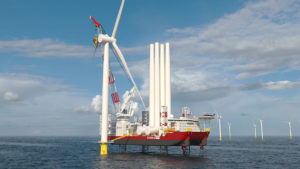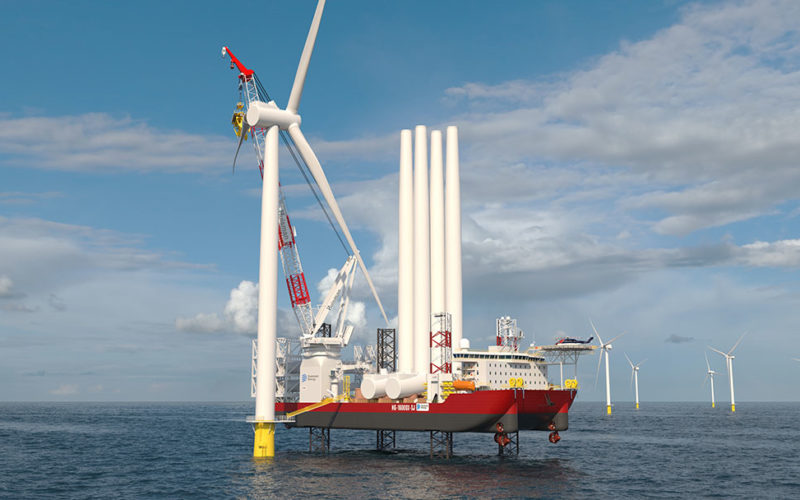
President Joe Biden has set lofty goals for offshore wind power over the next decade. Achieving them will require rapid growth in the offshore wind industry, which in turn could generate billions of dollars in new investment and thousands of new jobs.
“First and foremost, what we all need to understand is that this is a generationally changing opportunity for the United States, and in particular the maritime industry,” said Jeff Andreini, vice president of Crowley’s New Energy Division. “It’s like night and day.”
The federal Bureau of Ocean Energy Management (BOEM) in May approved the Vineyard Wind project that will site up to 62 wind turbines 12 nautical miles off Martha’s Vineyard, Mass. The project, a joint venture between Avangrid Renewables and Copenhagen Infrastructure Partners, is the first large-scale offshore wind project approved in the U.S.
Other large projects are not far behind. Dominion Energy, which recently built two turbines 27 miles off Virginia Beach, Va., is seeking approval for a 2.6-GW project that could grow to 190 turbines. The price tag is about $7.8 billion.
The five-turbine Block Island Offshore Wind project south of Rhode Island was the first project of its kind in the U.S. when it came online in late 2016. The 30-MW project generates enough power for about 17,000 homes.
Many offshore wind projects have been in the works for years. Several states have set aggressive targets for offshore wind, particularly Massachusetts, according to Liz Burdock, president of the Business Network for Offshore Wind. These efforts were slow to gain traction at the federal level as developers awaited key permits and approvals.
“We were at the point where, in late 2020, we had to have the federal permitting process pick up the pace, because we had 13 projects that had submitted their plans” to BOEM, said Burdock. “We were starting to get backlogged.”
Full-time jobs in the offshore wind industry are projected at 19,209 by 2025, according to a study done by the American Wind Energy Association.
The burgeoning industry is still building the infrastructure to support that growth. Andreini cited the need for new supply chains, training for mariners and the establishment of hubs along the East Coast where vessels and crew can be located. The industry also needs a fleet of specialized Jones Act-compliant support vessels. Crowley is opening an office and a maritime hub on the East Coast, where it will keep two-to-four ocean class tugboats and up to eight barges. In June, Crowley signed a contract with RelyOn Nutec to create a training program for the offshore wind industry.
The need for specialized vessels to help build, operate and maintain the wind farms is a challenge for the industry, which needs between 250 and 400 such vessels, according to Andreini. “Somebody has to step in and fill that void,” he said.
Specifically, the industry will need crew transfer vessels (CTV) to carry technicians back and forth from the offshore turbines for maintenance and inspections; service operations vessels (SOV) that help with turbine servicing and repair work and serve as in-field accommodations; feeder support vessels (FSV) to carry deck cargo such as turbines and blades to the installation vessel; and wind turbine installation vessels (WTIV) that physically build turbines.
Construction began last December at the Keppel AmFELS shipyard in Brownsville, Texas, on the first U.S.-flagged installation vessel. Called Charybdis, the 472-by-184-foot ship will cost nearly $500 million. Its main crane will have a boom length of 426 feet with a lifting capacity of 2,200 tons. Commissioned by Dominion Energy, it can also house up to 119 crew.
Dominion announced in early June that Ørsted and Eversource will charter Charybdis upon delivery, likely in late 2023. The two companies will use the ship to support construction of the Revolution Wind and Sunrise Wind projects planned south of Rhode Island. The two projects are expected to produce more than 1.6 GW of electricity.
As the oil and gas industry declines in the Gulf of Mexico and elsewhere, some expect a portion of these jobs will pivot into offshore wind. The Biden Administration in June announced efforts to explore offshore wind development in that region.
“There may be a decline in one industry but opportunities for people and companies with skills that are very transferrable” are opening up, said Matt Smith, director of offshore wind at the Hampton Roads Alliance.
The rapid pace of offshore wind development that many experts expect in the next decade portends a wave of new opportunity, said Bruce Harland, president of Crowley’s Wind Farm Program.
“Offshore wind power is the next big market in the U.S. and the next big offshore market,” he said. “I think in the next five years it’s going to overtake oil and gas in terms of revenue generation and opportunity.”

